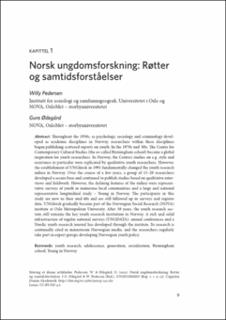Norsk ungdomsforskning. Røtter og samtidsforståelser
Chapter, Peer reviewed
Published version
Permanent lenke
https://hdl.handle.net/11250/2982825Utgivelsesdato
2021-11-18Metadata
Vis full innførselSamlinger
Originalversjon
https://doi.org/10.23865/noasp.142Sammendrag
Throughout the 1950s, as psychology, sociology and criminology developed as academic disciplines in Norway, researchers within these disciplines began publishing scattered reports on youth. In the 1970s and ‘80s, The Centre for Contemporary Cultural Studies (the so-called Birmingham school) became a global inspiration for youth researchers. In Norway, the Centre’s studies on e.g. style and resistance in particular were replicated by qualitative youth researchers. However, the establishment of UNGforsk in 1991 fundamentally changed the youth research milieu in Norway. Over the course of a few years, a group of 15–20 researchers developed a secure base and continued to publish studies based on qualitative interviews and fieldwork. However, the defining features of the milieu were representative surveys of youth in numerous local communities and a large and national representative longitudinal study – Young in Norway. The participants in this study are now in their mid-40s and are still followed up in surveys and register data. UNGforsk gradually became part of the Norwegian Social Research (NOVA) institute at Oslo Metropolitan University. After 30 years, the youth research section still remains the key youth research institution in Norway. A rich and solid infrastructure of regular national surveys (UNGDATA), annual conferences and a Nordic youth research journal has developed through the institute. Its research is continually cited in mainstream Norwegian media, and the researchers regularly take part in expert groups developing Norwegian youth policy.

